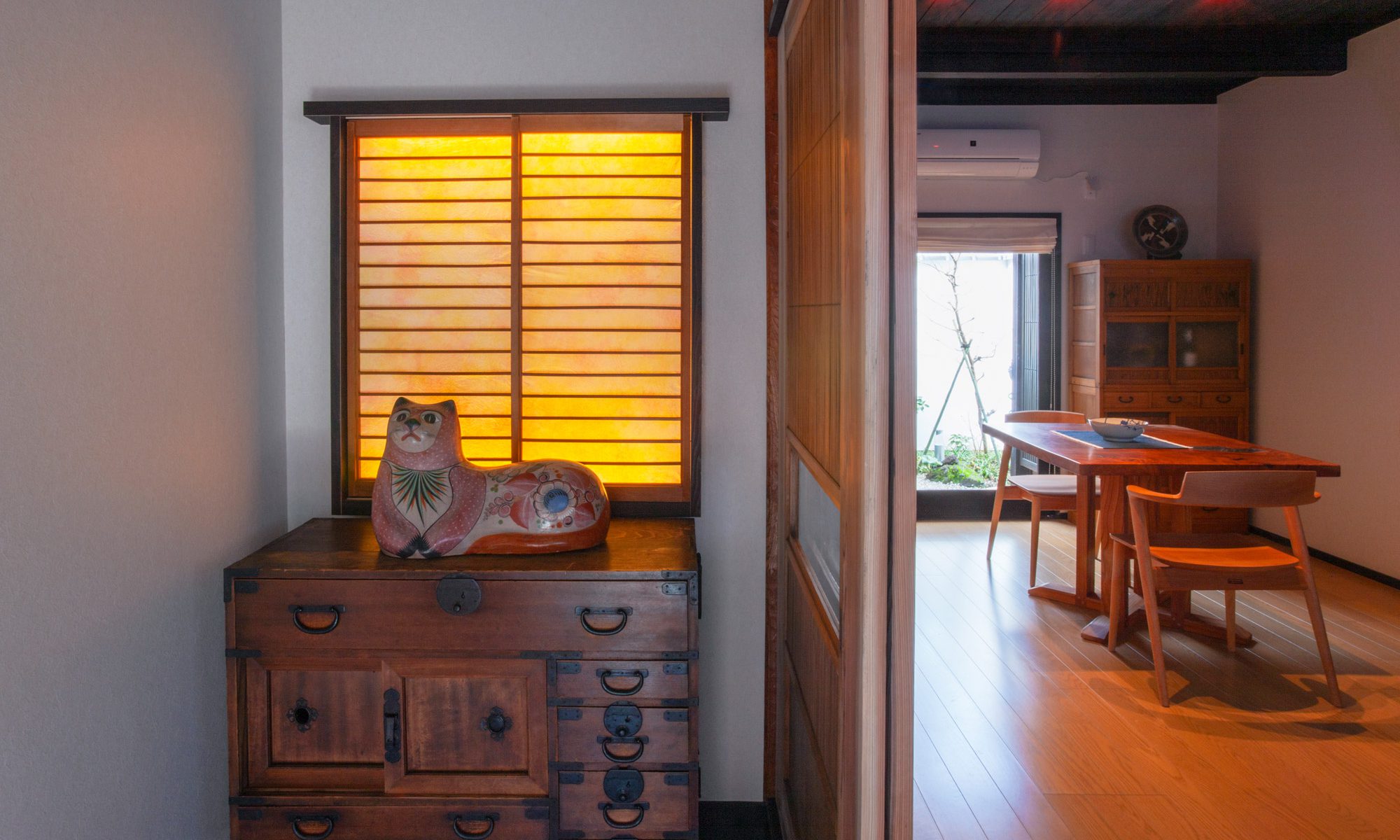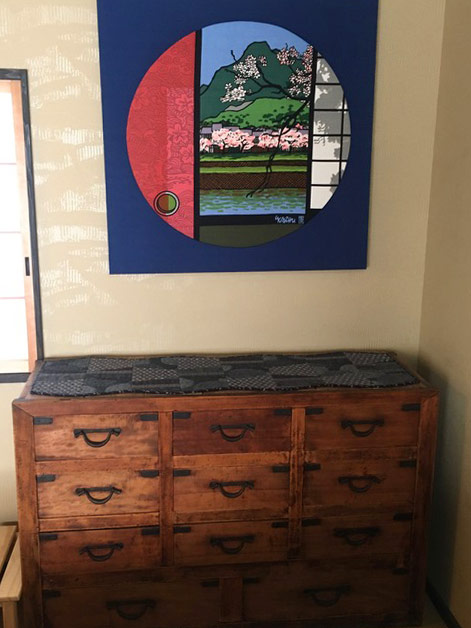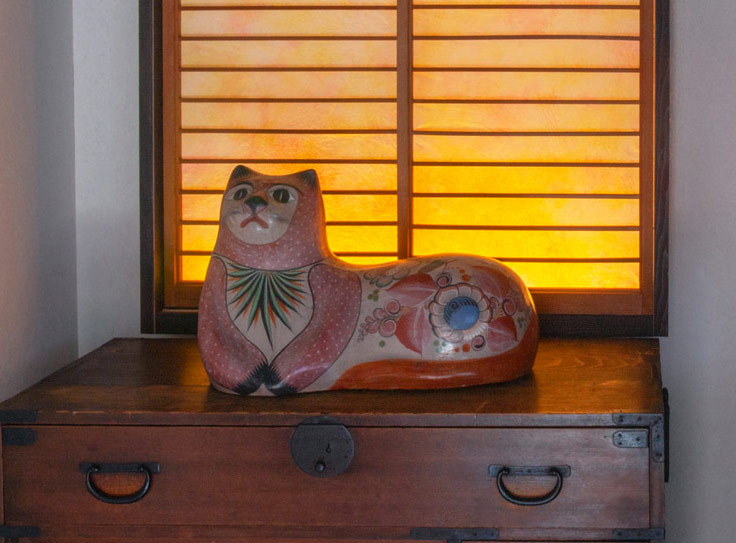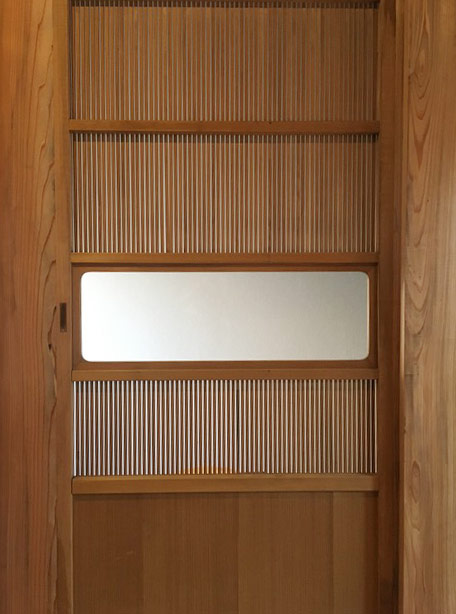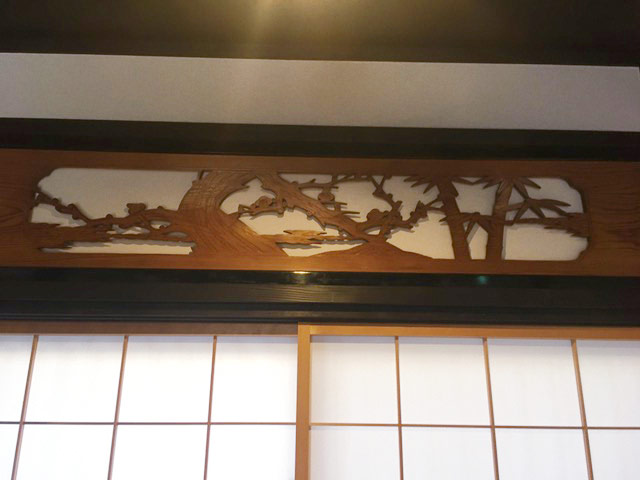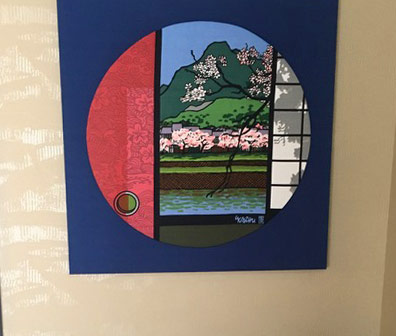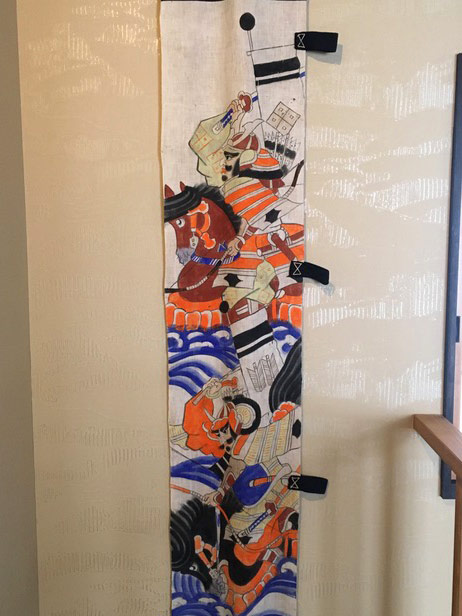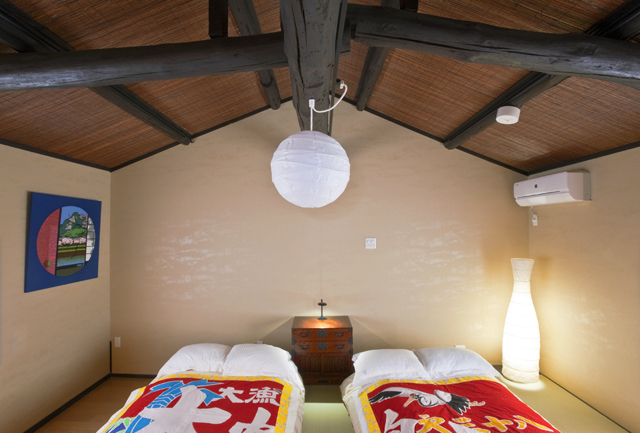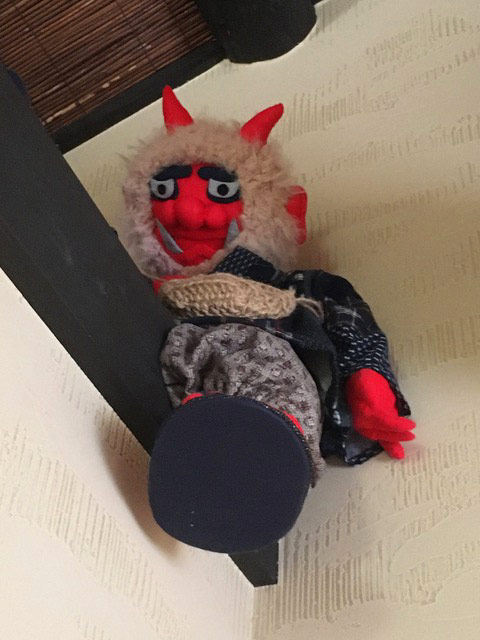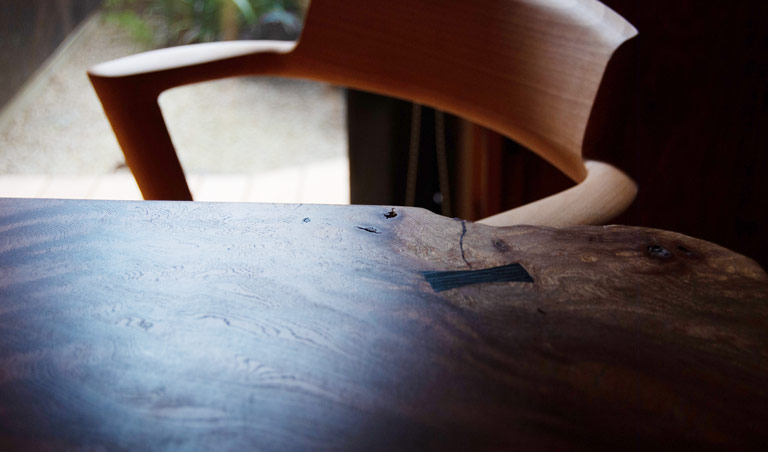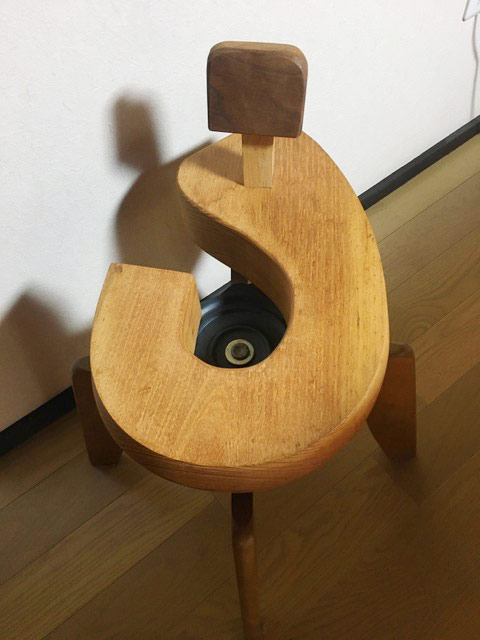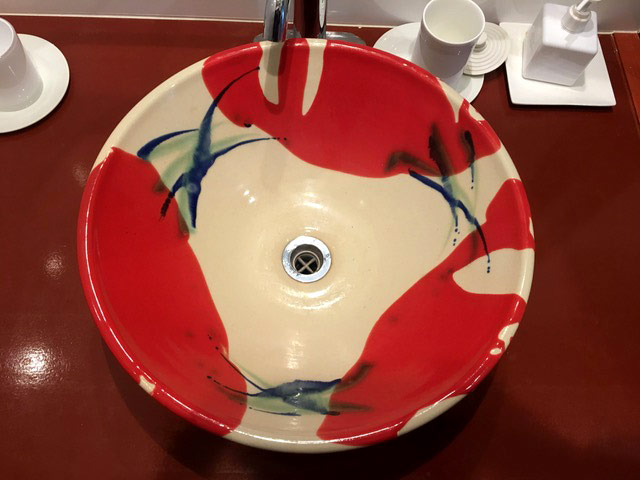
Kenkun House features some of the country’s folk-craft tradition of pottery, woodcraft, painting, weaving and dyeing that it has been my pleasure to obtain. Japan has a rich tradition of arts and crafts with many opportunities for shoppers. On the 16th of every month, there is a crafts fair on the grounds of Chion-ji temple. On the 21st, the World Heritage Site of Toji temple has another fair with used goods, antiques, plants, homeopathic medicines, a traditional meeting market place that dates back 1,000 years.
On the 25th of each month, on the shrine grounds of Kitano Tenmanju Shrine, is another market, both the temple and shrine hosts about 1,000 vendors. All you need is a pencil and paper to ask the price, and then offer your price for an amicable bargaining experience.
Chests of drawers
In the entrance is a chest of drawers made of paulownia wood, a soft light-weight timber that is used for this kind of furniture and most often seen in traditional geta footwear. The iron fixtures secure the corner sections of the drawers, and form the handles.
The kitchen cupboard is made of Japanese cedar, which uses textured bark as a façade on its sliding doors. Cedar trees cover the northwest mountain areas of the city and once truncated, also are used as a decorative garden tree. Unlike the paulownia chest in the entrance, this one has had translucent lacquer applied to highlight the wood grain.
The chest under the countertop in the kitchen and the one upstairs, were separated, the bottom section being filled with drawers, making it more suitable for holding clothing, and the top part for holding kitchen utensils. After cleaning this old piece of furniture, I applied wax to even out the color variation and enhance the grain of the cedar.
Items
Many shops throughout Japan have a cat figurine with a raised paw. This tradition is widespread in the country but originally originated in China where it was a folk belief that a cat scratching its ear indicated that a visitor would soon appear. Since all business people hope for customers, Japanese shopkeepers adapted this superstition and maneki-neko, populate shops throughout Japan. Maneki means to invite or welcome and neko means cat. The terracotta cat in the entrance is actually Mexican. I was lucky to find it in a used-goods shop, but instead of a raised paw, it welcomes visitors with a demure bow.
The light-wood lattice doors between the entrance and main room are cedar, and have been refitted to allow air and light in.
Transoms are found above the paper sliding fusuma doors that separate rooms in traditional homes. Plum, pine, and bamboo are very auspicious and these symbols are represented in the two lengths of wood carvings mounted as decoration.
The small wooden giraffe that sits on the stairs is African.
Painting
The painting in the stairwell is Korean folk art. Pigment on paper.
Upstairs is a cloth furoshiki, a carrying cloth, with the print of a woodblock print by Cliff Karhu. These and woodblock prints and carrying cloths are available from the Karhu Studio in Kyoto. Cliff Karhu was a long- time resident of Kyoto who worked with his son, Joel, who now continues to practice this artistic tradition. There are three prints: one of cherry blossoms along the Kamo River in spring; Willows along the Kamo River in autumn; and Drying Umbrellas in Gion for winter.
Hanging in the stairwell is a length of silk depicting the battle of Dan-no-Ura in which two famous clans, the Taira and Minamoto, battle each other in April, 1185, to win control of the capital. This famous sea battle has been recounted in films, novels, lyrics and art for centuries.
The winter bed covers are fashioned from a fishing flag form Shikoku with the name of the ship on it. These flags are decorative, bright and colorful, dyed especially for each particular boat for use in ceremonies within each fishing community. Boats festooned with flags are a beautiful sight during the New Year holidays when all boats are in the harbor so that fisherman can take their well-deserved holiday.
Another hanging length of cotton cloth hangs next to the washbasin near the bathroom. The distinctive black family crest is pictured above a playful fish swimming in the waves.
Textiles compose a large part of Kyoto’s traditional industries, mainly the weaving and dyeing of kimono and the obi sash. Kenkun House is located in Nishijin, the weaving and dyeing district of the capital. While walking around the backstreets, visitors may hear the sound of looms, electric as well as handlooms, being used.
Blue and red oni (ogres)
The blue and red ogres sitting atop the upstairs beams represent an old Japanese folk tale. These playful figures were made by a woman in Nara who hand sews using indigo cotton cloth for the clothing and amusing facial expressions of her own design. They are unique and a lucky find and of the scary creatures that live in the dark forests.
Long ago, in the deep deep mountains of Japan there lived two ogres, a red one and a blue one. The red ogre was very friendly but lonely and wanted friends, but everyone, especially children, ran from him. One day he asked his friend, the blue ogre, why no one liked him so the blue ogre proposed to scare some children, and allow his friend, the red ogre, to appear and rescue them. It was a success and the children came to play with the red ogre.
Later, the red ogre went to visit and thank his friend, but found a note on the blue ogre’s door saying that if the children think we are friends, they will not come to play with you anymore so I will leave. They never met again and the red ogre cried that his old friend had left.
To give the story another ending, I placed them upstairs to watch over Kenkun guests, and provide both ogres with friendly company.
Kitchen furniture
Zelkova is a large indigenous species of hardwood that is often used in temple construction, especially found in planked floors and pillars. The warp-resistant wood has a very distinct rich grain. Inwood Co. of Kyoto made this table for the kitchen. The comfortable chairs are of unvarnished birch. The swiveling stool is quite unique. The curved piece of wood is actually a hook that was used to hang a kettle over an open fire in old farmhouses. The craftsman inserted a back rest to produce this fun piece of furniture. He also made the wall clock with zodiac animals instead of numbers. Long ago, Chinese and Japanese divided the days not in numerals but by saying, a child was born in the hour of the ox, on the day of the dog in the year of the dragon. The artist’s wife made the animals and this zodiac clock was created. 12:00 is the hour of the mouse.
Pottery
Kyoto ceramics are very decorative, as befitting the capital and its aristocratic residents, but other simpler pottery abounds as well. The neighboring prefecture of Shiga, specifically the town of Shigaraki, which means Shiga ware, is definitely worth visiting as is the Miho Museum in that area. Shiga ware is a bit rougher and defined by its reddish color, and its slightly uneven surface when not glazed. It is used often for tableware as visitors will find fill the cupboard.
The pottery town is quite large with a variety of styles: rough and refined. The blue-and-white dishes with traditional motifs are also from the shop Maruka, like the washbasin in the bathroom. A few years ago, this type of basin became popular and the shop’s second floor has a good display varying in size and design.
